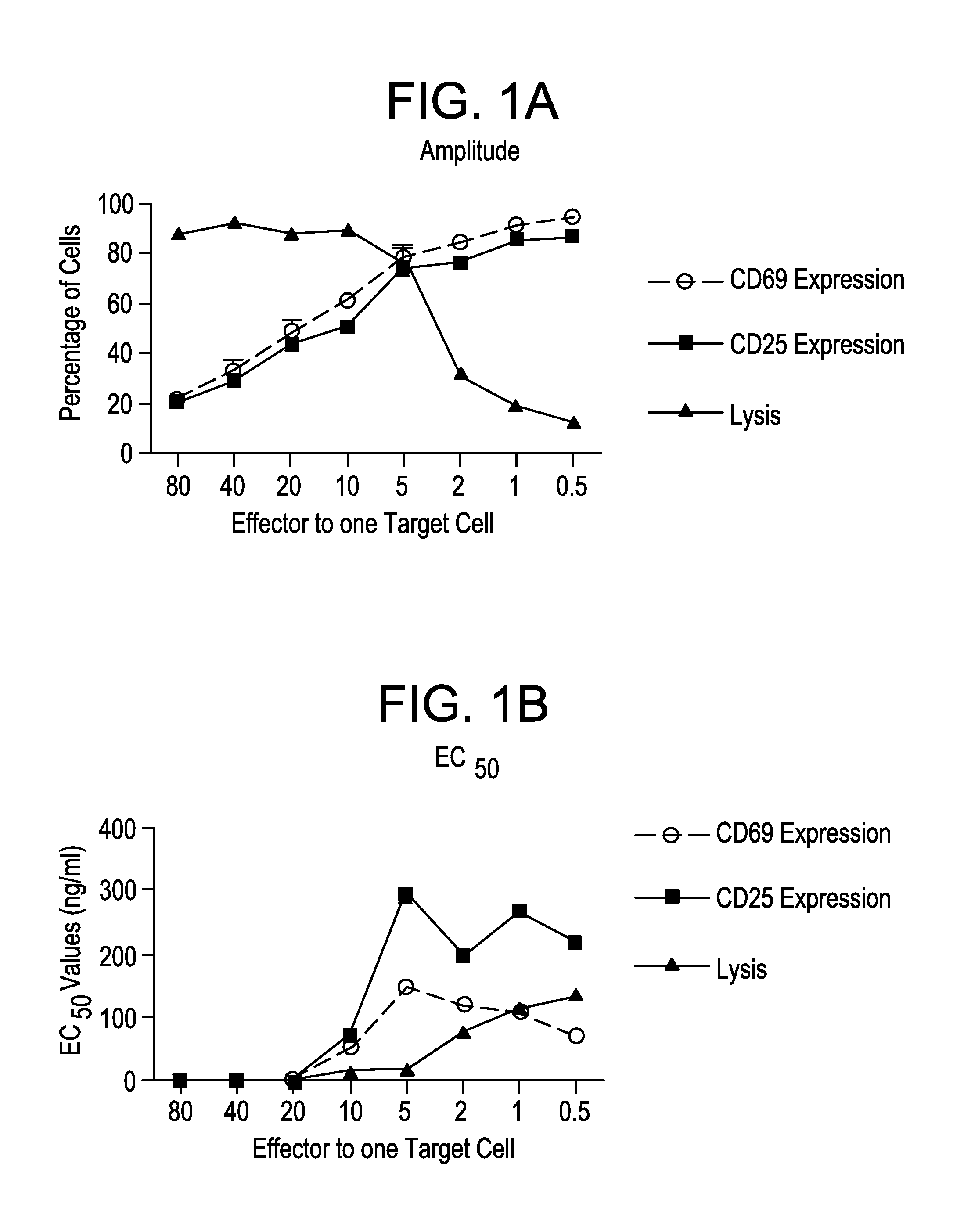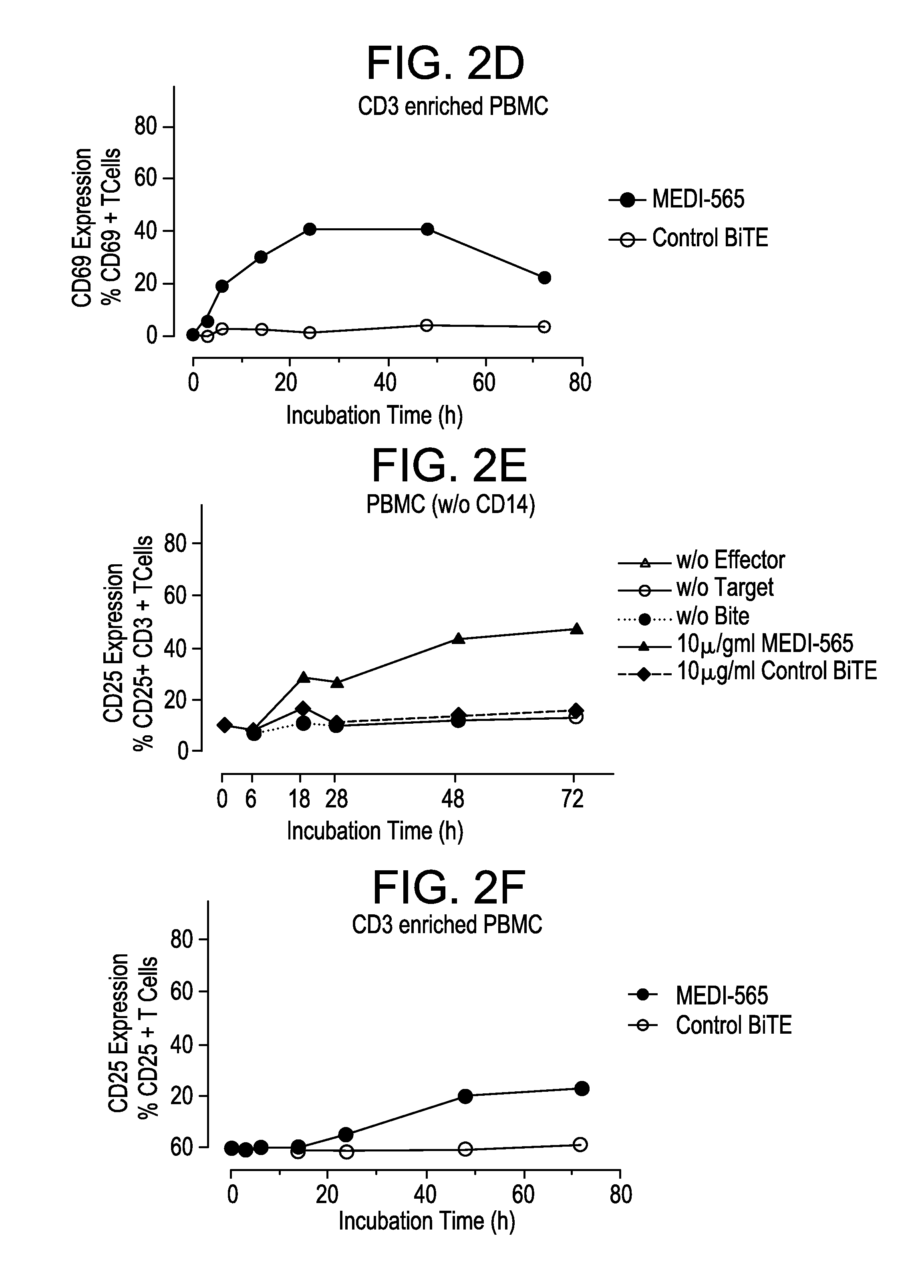Dosing regimens for treatment of cea-expressing cancers
a technology for cea-expressing cancer and chemotherapy, which is applied in the field of chemotherapy, can solve the problems of limited pharmacological testing of medi-565, and achieve the effects of increasing t cell activation, reducing tumor volume, and increasing releas
- Summary
- Abstract
- Description
- Claims
- Application Information
AI Technical Summary
Benefits of technology
Problems solved by technology
Method used
Image
Examples
example 1
Assay Development
[0215]A variety of CEA-expressing cell lines were tested as potential target cell populations for MABEL analysis in fluorescence activated cell sorting (FACS)-based cytotoxicity and T cell activation assays. Dhfr-CHO, MKN45, ASPC-1, BxPC3, and A549 cell lines were all tested. Two cell lines were selected as target cell lines for further assay development: CHO / huCEA, which are CHO cells that have been engineered to express high numbers of CEA cell surface molecules (340000±180000), and ASPC-1 cells (a human pancreatic cancer cell line). CHO / huCEA cells are sensitive to MEDI-565-induced redirected T cell lysis, are efficacious when used in T cell activation assays, and can be subjected to flow cytometry analysis. ASPC-1 cells are a human tumor cell line that naturally expresses CEA (about 90000 CEA cell surface molecules).
[0216]A. Determining E:T Ratios and Incubation Times for T Cell Lysis of CHO / huCEA Cells, T Cell Expression of CD69 and CD25, and Release of Cytokin...
example 2
Determination of MABEL for MEDI-565
[0260]A. MEDI-565 Specificity
[0261]The mode of action of MEDI-565 is dependent on the simultaneous linkage of huCEA-positive tumor cells with CD3-positive T cells. To confirm this characteristic, serial dilutions of MEDI-565 were incubated in the presence of ASPC-1 tumor cells only. Additionally, mixtures of tumor and T cells were incubated in the presence of serial dilutions of the control BiTE® antibody that exclusively binds to the CD3 antigen and does not bind to CEA.
[0262]MEDI-565 had virtually no effect on tumor cell lysis in the absence of effector T cells, even up to a concentration of 25 μg / mL, demonstrating that the anti-tumor activity is entirely mediated by redirected T cells (FIG. 13A). Similarly, the control BiTE® antibody had no detectable effect on target cell lysis (FIG. 13B) or T cell activation (FIGS. 13C and D) up to 25 μg / mL in the presence of huCEA-positive tumor cells. This demonstrates that simultaneous binding of the huCEA ...
example 3
Non-Clinical Pharmacology, Pharmacokinetics, and Toxicology Studies
[0276]MEDI-565 specifically and selectively binds to a nonlinear, conformational epitope in human CEA with a high binding affinity; it cross-reacts with chimpanzee and cynomolgus monkey CEA. In addition, MEDI-565 specifically binds to human CD3 with a low binding affinity, and cross-reacts with chimpanzee CD3, but not with cynomolgus monkey or mouse CD3. Concomitant binding of MEDI-565 to CEA and CD3 over a wide range of E:T ratios led to the activation of primarily CD3+ T cells and the subsequent killing of cells expressing CEA. In vitro cytotoxicity assays revealed that activation of T cells by MEDI-565 was specific and selective. At the same time, T cells expanded, increased cell surface expression of activation markers, and released proinflammatory cytokines, perforin, and granzyme B. Importantly, MEDI-565 did not activate T cells in the presence of cells lacking expression of CEA.
[0277]MEDI-565 was tested in pre...
PUM
| Property | Measurement | Unit |
|---|---|---|
| concentration | aaaaa | aaaaa |
| concentration | aaaaa | aaaaa |
| concentration | aaaaa | aaaaa |
Abstract
Description
Claims
Application Information
 Login to View More
Login to View More - R&D
- Intellectual Property
- Life Sciences
- Materials
- Tech Scout
- Unparalleled Data Quality
- Higher Quality Content
- 60% Fewer Hallucinations
Browse by: Latest US Patents, China's latest patents, Technical Efficacy Thesaurus, Application Domain, Technology Topic, Popular Technical Reports.
© 2025 PatSnap. All rights reserved.Legal|Privacy policy|Modern Slavery Act Transparency Statement|Sitemap|About US| Contact US: help@patsnap.com



